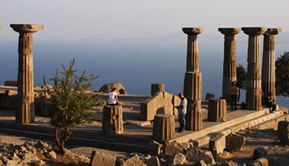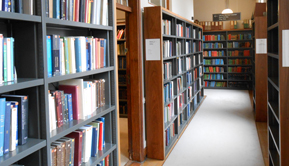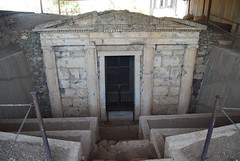A Q&A with Dr Ian Jenkins OBE of the British Museum
Caroline Mackenzie talks to the curator about his fleeting career as a stonemason, rendering the Parthenon Frieze readable to the blind, and a forthcoming exhibition on Troy

2018 marked forty years of your time at the British Museum – congratulations! Could you give a summary of your career?
Thank you! It has all gone so quickly. I wish I could do it all over again. I was a graduate of Bristol University and I did a stint as a stonemason. I was fascinated by stone and always have been. I went to see the Crafts Advisory Council at 12 Waterloo Place. They told me that if I wanted to be a stonemason, the only way was to be a stonemason. They advised me not to do a course but to get an apprenticeship or traineeship in a working commercial masonry. So, I did that in Bath for six months, and then they dropped a stone on my finger, so I sat at home reading Euclid, thinking perhaps I could develop my applied geometry and work instead in the drawing office and it would be less dangerous. However, fate intervened and my mother, having flagged down Mr Townsend the newspaperman, came in with a copy of The Telegraph (which we did not usually have) and when she opened it to read it, there was an advertisement for a job at the British Museum. I applied and got it and have loved it ever since.
What was that role?
Initially it was a junior role in the Department of Greece and Rome, and in those days, there was always a person responsible for education. It was Sir John Pope-Hennessy’s idea (he was Director of the Museum at that time and known to everybody as ‘The Pope’) that there should be a representative in each department responsible for that brief. I did it conscientiously and reorganised the Greek and Roman Life room, which is where school parties tend to gather. I also became Secretary of the Joint Association of Classical Teachers (JACT). I had benefited hugely by going to two JACT summer schools and acquired my basic Greek that way.
And the rest is history!
Yes. The Education Research Assistant posts were phased out and we were absorbed into the curatorial stream. I have become Senior Curator for the Greek section of the Department. There is also a Senior Curator for the Roman section.
What have been the highlights of your time at the Museum so far?
Digging in Turkey has to come high on the list. Otherwise, it is books and exhibitions that mark one’s progress, and I was thrilled when my PhD was turned into my first major book in 1992: Archaeologists and Aesthetes in the Sculpture Galleries of the British Museum 1800–1939. Strangely, the Museum had forgotten its own history and I had at my disposal the vast archive: original papers, periodic reports and discussion documents, all addressing the idea of a museum of national culture and how it should be displayed, what lighting should be like, what colours should go on the wall, what the consequences were of acquiring objects. I grew to understand the Museum as I think I could never have done if I had not embarked on this project. I was very kindly treated by the Museum as in 1984 I began the part-time PhD thesis which took me six years to finish and two years to turn it into a book. I never looked back really from that moment on. I became possessed of so much knowledge, and it was a great feeling suddenly to be empowered in the way that I was.
Then The Parthenon Frieze book came out two years later and here was a different challenge. The arrangement of the frieze had become very muddled. I put it into order, renumbered the blocks and sorted out the narrative. Working with that sculpture, which I have continued to do, is a great privilege and source of joy. It was bizarre to me the degree to which the ordering had not been interrogated. As a divertimento, but more than that really, I had this idea that everybody should have access to the Parthenon frieze and that if I pushed my book through the right machine, it would come out in relief and blind people would be able to follow it. I took the idea to the Royal Institute for the Blind and I also received $40,000 from generous American contributors. The resulting book is the one thing from which I think intellectually I gained most satisfaction.
May I touch the book?… It is incredible. In a way, this is the frieze in brail?Yes, it is. It is incorporated in one of the galleries here. I particularly love the way the figures sit like notes on a musical stave.
During your forty years at the Museum, what are the main changes you have seen?
When I first came to the Museum, mostly we were men. The advent of women has changed the tone and improved the place no end. A place which was once predominantly male is now, happily, mixed.
The second change is the Museum’s greater focus on the needs of the visitor in such creative acts as the making of the Great Court, which was to everybody’s advantage. The contribution that the Trustees have made in finding sponsors and supporters is enormous – people like me should be very grateful to them.
Can you remember your first ever visit to the Museum? Did you come as a child on a school trip?
I went to school in deepest Wiltshire but we did come to London with the school – we went to the Tate (now Tate Britain) with the art class. So I was not a child visitor of the Museum, but I did come as a university student.
Did those early visits have an impact on you or had you already caught the Classical bug?
I remember going into the school library and opening up a book by Maurice Bowra which was a popular picture book. It had a picture of the head of Apollo from the west pediment of the Temple of Zeus at Olympia and I thought, ‘I don’t know what that is and I don’t know how I am going to do it but that’s what I want to do’. I wanted to work with and make sculpture so I carried that with me, even to the extent of becoming a mason and finding that I didn’t actually have the aptitude.
One thing I can say is I had grown up thinking that talent was something that other people had, and they were actors, dancers, painters or famous dramatists. I had not realised that my gifts were reading and writing and these were my X-factor: it was what I was meant to do. When I stopped punishing myself for not being a famous actor and started to rejoice in the fact that I could be creative with the talents and skills that I did have, that was happiness.
I think everyone has creative power but many people go through life without actually realising what they are good at is something closer to home than they think.
A lot has been written about the relevance of ancient Greece to the modern world. Are there any particular aspects which you think are worth reinforcing?
I am a great fan of Socrates and I find Socrates’ wisdom increasingly apposite and a great source of courage and integrity. In Plato’s hands, the legacy of Socrates is probably the greatest gift that antiquity gave the modern world: the Socratic dialogues and their constant search for truth and absolute virtue is something that St. Paul introduced into the Christian doctrine and made part of our own moral aesthetic. It is amazing to think that moral philosophy was really invented in Athens in the 5th century BC and the Greeks interrogated what it was to be human and then shaped the human condition on the basis of what they found.
You don’t appear to have a bust of him in your office?
No. The best portrait of him we have is the nearly full-length statuette – the only full-length statuette in white marble.
What is the main impact of the Greek and Roman galleries on visitors?
I am not sure. I sometimes think the labelling of the sculpture in the galleries should not be left to we archaeologists when what we should be trying to do is to reach out to people (this is something our current Director is keen on) and say to them that you don’t have to be an expert in Greek archaeology to enjoy this object and you can express your feelings in any way that you feel comfortable with and nobody is going to say that is wrong.
In other words, there is much more than just one interpretation?
Yes. When we held the exhibition Defining Beauty: the body in ancient Greek art (2015) and Rodin and the art of ancient Greece (2018) I did feel that we were writing different kinds of labels and information panels than previously. They were more poetic. Still, they did not go so far as I should have liked. You could translate the ancient object and its archaeological narrative to give it a new metaphorical meaning. The approach would be less academic but you might connect more deeply and with a greater number of visitors. It is the difference between the simple archaeological labelling of an object and telling a story. I shall give you some examples [from the 2008 Far East tour exhibition catalogue]:
This boy looks as though he has had his school uniform bought for him too long so that he will grow into it and he is hating the feel of his new ‘dress’. It is his first day at school and his Mum is so loving and finds him so cute that she has left the car purring in the drive and has gone inside to get the brand new camera and has taken a picture of him. That is him having his picture taken. The sad thing is that this boy will not survive – this statuette will be put into his grave, so thank goodness she took that picture.
These two girls are on the edge of childhood and they are insouciantly playing a game of knucklebones while their parents have retreated to the cool of their house in the heat of the day. They bow their heads to the sun and childhood passes.
This old lady has lived far beyond the normal length of time on earth and any ill wind bearing any form of illness could carry her off. This child is equally challenged and could be at any point dismissed to the Underworld; but she is laughing at the child and the child is laughing at her and between them they defy the evils of the world.
That is a great way of capturing the objects for someone who does not know any archaeology.
It opens up the subject to people. It is also in the spirit of Greekness. The Greeks did not have a nation state, they had city-states and their concept of Hellas was not a solid, monolithic, defended, boundary-conscious preserve. It was something more cultural, societal and spiritual so if you spoke Greek and you worshipped and acknowledged the Greek gods and you had values in common with Greece, you were Greek. You could be black or white, from South East Asia or from North West Europe, and either way you were allowed to be Greek. It is a lesson for us all.
Regarding the limitations of museum display, you have written about the Rodin exhibition and how the Parthenon sculptures were displayed at a lower height, allowing visitors a more intimate experience than in the Duveen Gallery. This allows the Museum to tell more of a story.
Yes, we were amazed at what we noticed and how differently they appeared. We also discovered colour which was the first time we found colour that can be seen with the naked eye – on figures L and M [pictured below] – there is an ongoing research project around the colour, combining scientific and archaeological interest in the surfaces and the surface treatments of the sculptures.
I learned a lot by doing that exhibition and I take my hat off to the designer and the lighting specialist – they made it dreamy. I loved the first room with the silvery-white effect to contrast with the black art installation effect. They were magnificent projects.
What can we expect from the upcoming Troy exhibition this autumn?
I am not actually part of the team but from what I can gather its focus is the reception of Troy in antiquity and in the modern world. It is an exhibition that visualises the innate struggle between East and West and how Troy is invoked. Because Virgil called the Trojans Teucri they became easy for the Turks to identify themselves with and Mehmed the Conqueror saw his conquest of Constantinople as quid pro quo for the invasion of the Persian empire by Alexander the Great.
Troy is one of those emotive subjects and some parts of the Iliad are so painful that it becomes almost unbearable. For example, when Andromache goes up onto the walls and takes Astyanax with her, Hector comes hotfoot from battle and the nodding crest on his helmet upsets the child. Then Andromache pours out all her fears about all the horrors that the world will hold for her. We have a Greek vase on which Astyanax is used as a club by Neoptolemus to bludgeon poor old Priam to death. It is about the way in which Troy is a vehicle for expressing our responses not just to the ancient world but also to the modern.
How much of the real Troy do you think was reflected in Homer?
People have spent their lives trying to sort this out, but I feel it is slightly missing the point. It’s like the approach that people take to the Parthenon frieze: ‘it has to have a single coded message and if we can’t have that, we haven’t deciphered it.’ For example, staying with the frieze, a word which comes to mind is pageant. Plutarch says that Pericles liked to bring together the kaloi kai agathoi [the beautiful and the good] and they together would represent the best of society. Pericles was always devising pageants for them so that they could see and be seen. Returning to Homer, trying to turn him into an archaeologist somehow undermines the true value of his work, as does trying to sort out which bits are Homer and which are not. The indelible hallmark of Homer (whether he wrote it or not) is in every beginning and every end of each book in the twenty-four book cycle; just as the Parthenon frieze is ostensibly the work of one man. It is not that he carved it all but he designed it and envisaged it. We know that Pheidias was possessed of phantasia: the ability to imagine something and then bring it to life. He greatly admired Homer, especially in the portrayal of the gods.
You have written about this in relation to Rodin’s work: there is a blueprint which infiltrates everything and it does not really matter who sculpted every tiny part as the spirit of Rodin pervades everything. Rather than overanalyse Homer, therefore, perhaps we should just enjoy his genius. You mentioned earlier the image of Neoptolemus on the vase…
A horrendous image. Achilles is a monster, but he has some scruples and observes some of the laws of courtesy and fair treatment of people in that he allows Priam to come to him and Achilles eventually gives up Hector’s corpse. But Neoptolemus inherits all his father’s bad side and none of the good – he is simply a monster. His behaviour towards the royal household of Hecabe and Priam is just too much. In war, everybody is transformed and in Euripides’ Hecuba Hecabe is depicted as becoming a dog with bloodshot gaze while in Dante’s Inferno she is described as barking like a dog which is so sad.
Do you have any other exhibitions planned?
My current project is to re-present the labels and information panels in the Parthenon gallery because it is twenty years since I did it last and I would like to refresh the commentary and also to try to incorporate into the labels something of the magic which we discerned in the Rodin and Defining Beauty exhibitions. We are not going to wear our hearts on our sleeves but we want to be a bit more poetic.
You mentioned the Director of the Museum earlier in our conversation; it was reported in the press last year that he wanted to reorganise the collections on display.
The problem is that to renew the Museum is a huge undertaking. But then, I did not think the Great Court was achievable, but looking back it now does not seem such a huge amount of money. Every director likes to build and wants to redisplay so it is our job to try and achieve what each director wants.
Amongst our readers, there are likely to be some prospective museum curators. Do you have any advice for them?
People look at my profile on the internet and think, ‘his job looks interesting, how do I do that?’ and they start to think about it quite young. However, I think it is a shame to fret your way through later school life and degree because you don’t want to lose sight of the prospect of employment and then when it doesn’t come, you are disappointed. It is a great privilege and a wonderful experience to be able to read Classics at University and it is the only time in their lives when they are going to be able to do so without their minds being cluttered with the necessities of life. You cannot control the future, you cannot change the past; the zen of living is to be in the present.
So prospective curators should just enjoy what they are doing: carpe diem?Yes, it is such a casino when you come to try and get your job. Just like my Mum bringing in the newspaper – you have to be in the right place at the right time. But what is the right place at the right time? I think people should always follow their desires even if they may lead into cul-de-sacs. They should always do what they think is right at the time.
I can second that advice from my own experience – after a degree in Classics, I pursued a career in law for eleven years but my passion for Classics resulted in me doing a full circle and returning to the world of Classics.
That’s very good! Actually, I wrote my undergraduate thesis on Plato’s thinking on law and Aristotle’s criticisms of it – I still have it somewhere!
That passion will always carry you through to your next phase. Did you feel empowered when you started learning Greek? I felt hugely empowered.
Absolutely – as if I had discovered the world’s best kept secret!
I felt as if I had been let into the garden of delights and everything was in bloom. Anything was possible and there was this language which was rich and full of sounds.
What are your thoughts on the future of museums generally?
The big question currently is, ‘Do we all subscribe to the enlightenment values of the 18th century?’ Do we accept that there are certain things which we hold in common, like the legacy of philosophy and the importance of the individual, and the observance of principles? I feel I work in an institution where all cultures are shown but none is privileged, and all religions are represented but none is preached. It is the ability to stand back and look through the window at other people’s lives and empathise and put your own culture to one side and come to understand that of another. This institution born of the enlightenment suits me very well in its function as a world museum. I think there is also another legitimate museum type, the ‘mirror museum’, which is somewhere you can go and see your own culture reflected back at you. Rather than a window where you look through at others, you look into the mirror and you see yourself reflected in the history of your city or part of the material world. I think that is what the Acropolis Museum is (it is wonderful). We are the other type. We are between the window and the mirror.
What is your involvement with the Hellenic Society?
The Hellenic Society and its journal have always been important to me. I have been on the Council and have reviewed for JHS, which has to be the classicists’ top journal. [Note to editor: he had not seen ARGO at the time of the interview…] Nowadays, my contact with the Hellenic Society is with the Joint Library of the Hellenic and Roman Societies.
As a final question, if you had to pick just one object from all the collections in which you have been involved, which would it be?
Goodness! I should choose something from the sculpture, but I think it would be a vase and it would be Exekias’ vase of the death of Penthesilea, the Amazon queen, at the hands of Achilles. The point at which Penthesilea’s open-faced helmet allows her eyes to penetrate the eyes of Achilles who is wearing the mask of the Corinthian helmet, and that moment when his spear begins to release blood from her neck as she engages him in eye contact and he falls in love with her. Everything that leads up to that and everything that leads away from it is gathered into one image.
I wouldn’t mind the vase that sits behind it, too, which is the one with Memnon dressed as a Greek hoplite and two Africans on either side.
There is something brilliant about the design of Exekias’ pottery but also his ability to conjure up atmosphere from graphic images, the shape of the pot, the setting of the image on the vessel, the use of spirals to frame it, and the way in which writing forms part of the pattern. It all pleases me as a complete entity. I admire it for its perfection. Of course, I admire the sculptures hugely, but if I were to take one thing with me, I think it would have to be that.
Dr Ian Jenkins OBE, FSA is Senior Curator, Ancient Greece at The British Museum.









